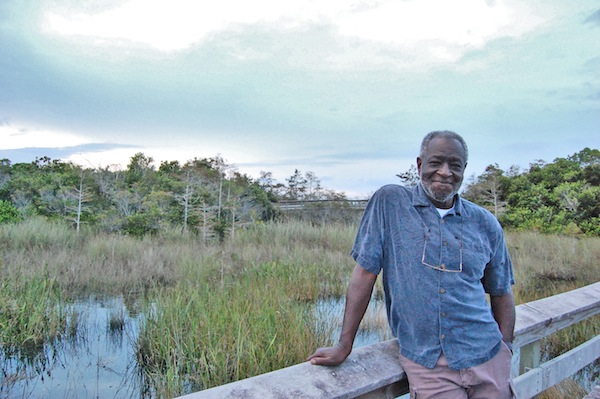
Living in the River of Grass
By Bill Maxwell, AIRIE Fellow Bill Maxwell at Everglades National Park
‘When I was a boy in Scotland I was fond of everything that was wild, and all my life I’ve been growing fonder and fonder of wild places and wild creatures,” conservationist John Muir wrote in his essay “A Boyhood in Scotland.”
If you change Muir’s Scotland to Florida, you get a good description of my childhood and how my love grows each day for what remains of the Sunshine State’s wild places, particularly Everglades National Park.
Muir was born in a tiny town on the North Sea, where the wilderness reached for miles in all directions. I was born in Fort Lauderdale, a mid-sized city on the Atlantic Ocean. The Atlantic, too, is a wilderness. It was not accessible to a child. I could only stare at it from shore, swim near shore and fish from shore.
To the west of Fort Lauderdale, however, wild regions of Greater Everglades sprawled west toward Naples, north toward Orlando and south to Florida Bay. I began my forays into the Everglades when I was 6 or 7 years old, when I went with an uncle to fish in “secret spots” he and a buddy discovered along U.S. Route 27.
My uncle constantly had to yell, “Boy, you got a bite,” to let me know my bobber had been submerged a long time.
I would be daydreaming, mesmerized by swaying sawgrass, strands of bald cypress and the spectacle of snowy egret, white ibis and other waders on the hunt. Cypress domes and hardwood hammocks in the distance intrigued me. I imagined that they concealed deep pools where alligators and other ferocious animals hid from human eyes.
As I matured, becoming a self-assured adventurer, I trekked deeper into what naturalist Ted Levin calls our “liquid land.” When I was 14, I discovered Everglades National Park itself. Since then, I have returned countless times, slogging the sloughs, camping, kayaking, fishing, bird-watching, staying in the now-gone cabins and relaxing for extended periods on a house boat.
During my first slog through a periphyton marsh, I learned that this so-called swamp is not a wasteland of putrid, stagnate water. I saw that the shallow, slow-moving water is clear, revealing a world of fish, other creatures and plants.
When I taught at Florida Keys Community College and Broward Community College, I brought hundreds of students to the park for writing assignments and for the sheer enjoyment of this treasure.
And today, I am living a dream.
As a journalist who often writes about nature, I am an artist-in-residence in Everglades National Park. I have been here since Oct. 30. My residency ends Dec. 8, after which I have a year to publish an in-depth commentary on the progress of the Comprehensive Everglades Restoration Plan. I am spending my time exploring, researching, interviewing sources, keeping a journal and enjoying my good fortune.
Living in the park has taught me something that Muir, Aldo Leopold, Henry David Thoreau and other nature writers were keenly aware of: Those of us who love natural places, especially our national parks, have a special way of being in them. By being, these writers meant our state of consciously existing in wild environments. Some nature writers even describe wilderness as “sacred” places.
Being in the Everglades is unique to each person. But all of our ways of being have one thing in common: We are individually transported beyond our normal selves as we sense the essence and uniqueness of the River of Grass.
Everglades National Park, a World Heritage Site, is special. Unlike other national parks, it was not established for spectacular vistas and awe-inspiring scenery. Its purpose is to protect our wildlife and waters. When we enter the park, we do not expect to see geysers, glaciers or bottomless canyons. We expect to see alligators, wading birds, raptors and plants that do not exist anywhere else on Earth. And we wistfully hope to see an endangered Florida panther.
We come here to see wild things.
That expectation alone gives us a special way of being in the park: I am reminded that I am an animal, the human animal, a term used by conservationist Ian McCallum in his book Ecological Intelligence: Rediscovering Ourselves in Nature. Indeed, I realize that I am naturally linked to other living creatures here and that I am the only animal in the park possessing the power to destroy everything here. Instead of giving me a sense of dominion, this awareness humbles me, making me grateful to be in this one-of-a-kind wilderness.
Having the good fortune to be an artist-in-residence has taught me that I am part of the great chain of being of life in Everglades National Park.
Recent Content
-
Artsarticle ·
-
Artsarticle ·
-
Artsarticle ·
